Menu

Did you know the livestock monitoring market will almost triple by 2030 to USD 3.7 billion? It was worth USD 1.6 billion in 2022. This huge growth shows how AI in farming is making a big difference.
Keeping an eye on livestock health is now easier thanks to technology. It’s changing how farmers work, bringing better care for animals. Livestock technology, powered by AI, is at the heart of these significant changes.
Livestock farming is vital to our lives. It provides food and jobs around the world. But it faces challenges like animal welfare and harm to the environment.
Now, AI is offering new ways to tackle these issues. By using smart devices and technology, farms are becoming more efficient. This helps not only the farmers but also the animals they care for.
The future of farming looks bright, with the autonomous livestock feeding market set to grow to USD 8.64 billion by 2030. This growth, driven by AI, is focused on better livestock care. A great example is ZELP’s AI, which reduces cattle methane – a move that helps the planet.
Overall, AI is rapidly changing farming for the better. Many are investing heavily in technology for agriculture. Initiatives like ‘FutureTech with Yanyan’ are showing us this exciting new path.
Farming has changed a lot due to digital livestock monitoring. AI is now at the heart of this change. It allows for precise and efficient monitoring of animals unlike before.
In the past, farmers checked on animals themselves. Now, technology has changed how this is done. AI and sensors help them keep an eye on animal health and behaviour all the time. This makes it easier to see when there might be a problem.
Advanced tech is key in the new face of farming. It includes sensors and AI for more precise farming. These tools help watch how animals are doing, spot issues early, and plan feed better. It makes the animals healthier, increases farm output, and gives farmers more useful information.
Drones and RFID tags also have big roles. They help track and manage animals more easily. This means less work for farmers and smarter farming overall. As AI tech gets better, farming will keep improving, showing how well tech fits into farming.
“The world’s population is projected to reach 9.15 billion by 2050 (Alexandratos and Bruinsma, 2012), necessitating the adoption of efficient smart farming solutions to meet the surging demand for animal products while addressing quality and environmental impacts.”
The move from manual to digital livestock care is more than just getting new tech. It shows we’re serious about better, greener farming. This change opens doors for even more new ideas that will make farming better in the future.
AI is changing how farmers care for their animals. It makes keeping an eye on livestock more accurate and efficient. By using AI, farmers can watch their animals closely. They can spot health issues before they become serious. This early warning helps keep the animals healthy and reduces the risk of lost animals.
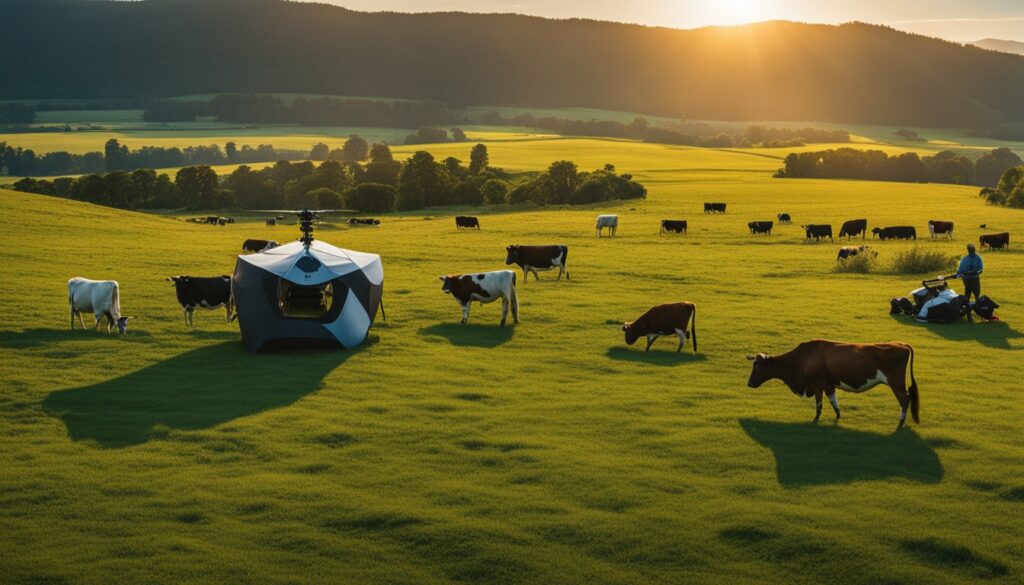
AI watches over the animals’ health through sensors. It tracks things like body temperature and how active they are. This way, if an animal gets sick, the farmer knows quickly.
Seeing this info over time helps farmers take care of their animals better. With AI, they can manage their animals’ health really well. This means less sickness and happier, healthier animals.
AI helps farmers make really smart choices about how to look after their animals. It figures out the best food and living conditions by looking at lots of different information. This smart use of information makes farms better for the animals and the environment.
This means farming is both better for the planet and more successful. AI is a big part of making farms work well and stay profitable.
AI also does some of the work of looking after animals. It can count them automatically and check their health on the go. AI even helps decide which animals should breed together. All these uses of AI are making farms of the future more efficient. And by the year 2030, the world’s AI farming market is expected to be worth over $8 billion.
Precision livestock farming is changing how farming works. It uses data to take better care of animals. By using smart sensors, data analysis, and AI, farms can work better. This approach isn’t just about managing each animal better, but also solving big farm problems.
Artificial Intelligence (AI) is transforming precision livestock farming, providing farmers with valuable insights to enhance animal welfare, productivity, and sustainability practices. AI technology aids in disease detection and prevention by analysing data from sources like sensor networks and medical records, leading to early identification of health issues, minimising disease spread, and reducing antibiotic usage.
AI-powered feed management is key here. It tailors each animal’s diet to its needs. This not only cuts down on waste but makes farming more eco-friendly. It shows how using data wisely can have big benefits.
AI also helps with animal breeding. It uses data to find the best times to breed. This means less need for hormones and a natural way to grow the farm.
AI is also used to watch the farm’s impact on the environment. It looks at data from sensors and satellites to protect nature. This high-tech farming method also keeps an eye on the animals, making sure they’re safe and healthy.
The AI Market uses tech like Machine Learning, Computer Vision, and Natural Language Processing. These tools help with everything from health checks on animals to making smart decisions, pushing farming into the future.
The way we manage animal farming has changed a lot with automated systems. They use real-time data to be very exact and efficient, which is important in today’s farming.
Smart tags and sensors are key in the new livestock management. They track animals well and look out for their health. These tools can pick up on early signs of sickness by checking body temperature and activity. This keeps the animals healthy and helps the farm run better.
Automated farming is amazing because it gathers and uses data instantly. Such tech keeps an eye on animals 24/7, letting farmers act quickly to make things better for their animals. It’s important for fast health care, perfecting food plans, and checking the farm’s environment.
Using AI to manage the data makes the whole system more flexible and smarter. It cuts down on time spent on routine tasks, letting farmers focus on making their farms better. This boosts how efficient and profitable the farm is.
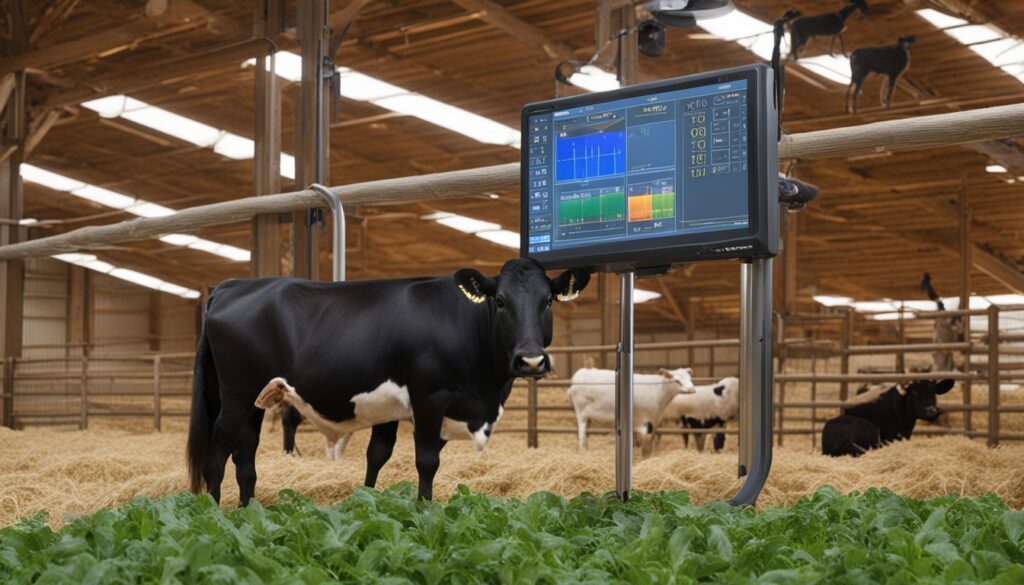
High-tech tools like smart sensors and AI are steering us towards better farming. As these systems get better, they promise to make farming more advanced and sustainable. With real-time data and clever sensor tech, the future of farming animals is looking bright.
Steps to boost animal welfare involve looking at physical health, where animals live, and how they act. Old ways of checking animals can take a lot of time, be inconsistent and difficult. The use of AI in caring for livestock provides a great answer to these problems.
AI and sensors keep an eye on animals with their health, body changes, and how they move. By tracking these things all the time, we get very accurate and early information. This can stop health problems before they start and makes sure animals live in the best way possible.
This AI method for ethical farming innovations checks several key areas:
We must see these signs as linked parts for a full check. James Chen got a big grant to make a tool that hears animals and supports health and less gas. This tool uses sounds from animals to find stress or sickness with USDA help.
This tool looks deeper at vocal sounds and connects them to health data like cortisol to see real stress. It also helps pick cows that make less harmful gas by listening to them, to see if it’s from their genes or where they live.
| Indicator Type | Monitored Data | AI Role |
|---|---|---|
| Health | Body temperature, heart rate | Predictive analysis, early health issue detection |
| Behavioural | Movement patterns, vocalisations | Comfort, stress, and frustration level assessment |
| Physiological | Stress responses, environmental impact | Objective assessments, environment adaptation |
This technology helps us watch many signs to make sure animals live well. It joins being kind to animals with working well and not damaging the environment.
AI is making big changes in how we watch over animals. It’s growing fast with new tech and ideas. Looking ahead, many things will transform how we care for and watch animals. But, there are also problems we need to solve.
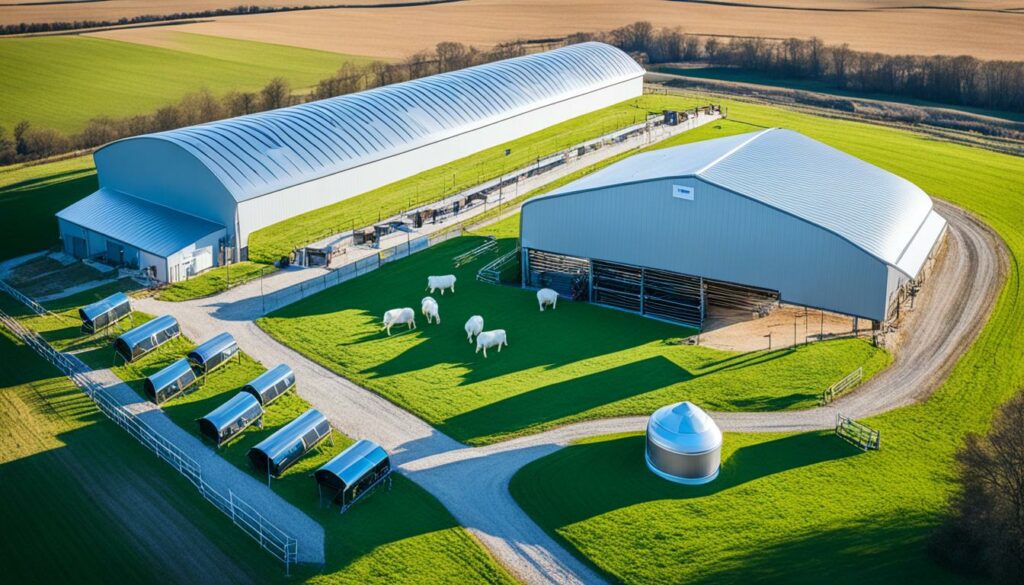
AI is changing how farmers keep an eye on their animals. It helps track things like temperature and movement. This early warning can prevent health issues. AI also makes animal food better by looking at the weather and health of animals. This way, animals eat well and perform better. Plus, AI helps farmers lessen their impact on the environment by checking soil, air, and water.
There are tough parts in using AI for animals. One big issue is not having enough good data. But, groups like Digi4Live are working on this. They share data to make AI models stronger. To succeed, farmers must see the good AI can do. Teaching them and being clear about the benefits helps a lot.
| Key Trends | Statistics | t
|---|---|
| Revolutionising Animal Health Monitoring | AI technologies allow real-time tracking of parameters like temperature and behaviour. | t
| Optimising Nutritional Programmes | AI-based algorithms enhance feed efficiency and animal performance using diverse data sources. | t
| Environmental Impact Management | AI-powered analytics help minimise environmental footprints by analysing soil, air, and water quality. | t
Thinking ahead will lead to better animal care and farm work. As these AI tools get better, farms will be more productive and better for animals. Solving these AI challenges will help farms be smarter and work together. This brings a better, lasting future for farming.
The AI market for keeping track of farm animals is booming. It’s seeing a lot of money and new tech. By 2033, it’s estimated to be worth almost USD 3 billion, growing at a rate of 23.8% every year.
In 2023, software was a big part, making up 53.1%. This helped handle data well. Big farms, with their ability to grow and lots of money, owned 68% of the market. In places like North America, with its advanced farming and strong government help, the market reached 37.5%. About $650 million was spent to monitor animals better, reducing deaths by 20%.
Big names in AI farming, like Smart Ag and Lely, are introducing new tech that is changing how we farm. They’re bringing in things like self-feeding machines and smart health tracking. In 2023, a lot of money was put into stuff like automatic milking and smart cameras for the animals. These technologies made milking 22% more efficient and made animals 22% happier.
Lots of farmers, about 75%, are now using AI to make food for their animals better and cheaper. This has made the food 15% more efficient and saving them 12% in costs. A new way of farming, called Precision Livestock Farming, uses AI to check each animal’s health and happiness carefully. Technologies for predicting when machines might break got about $280 million. This shows big interest in using new tech for farming better and smarter.
The use of AI in livestock farming has changed how we see livestock sensors. Thanks to AI-driven tech, farmers can keep a close eye on things like temperature and movement. This lets them step in quickly and keep the animals healthier.
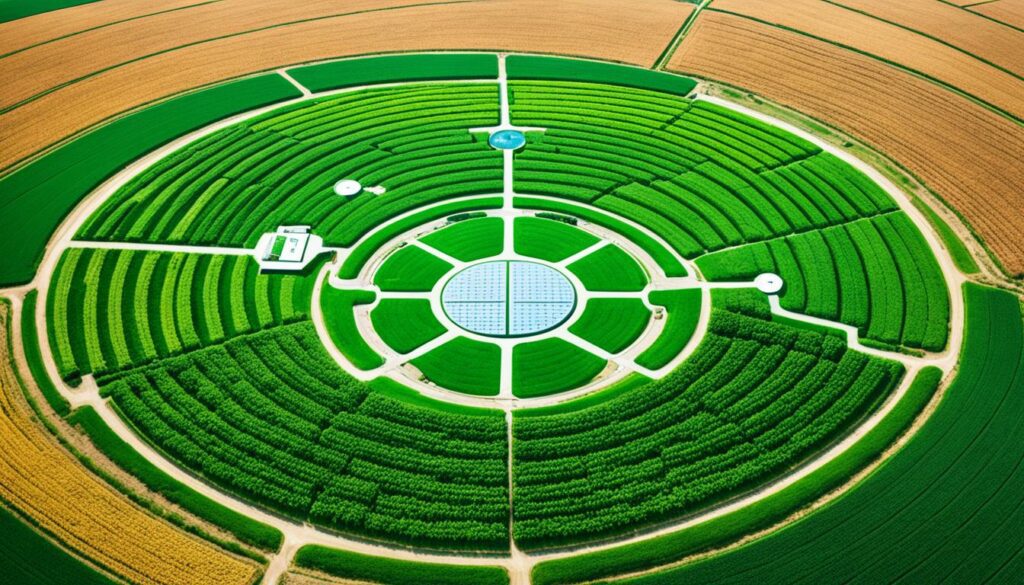
Modern sensors track both an animal’s body heat and how much it moves. They give constant updates, spotting any signs of sickness early on. This means farmers can act fast to keep their animals well, leading to more productivity and fewer deaths.
| Parameter | Monitoring Technology | Benefits |
|---|---|---|
| Temperature | Thermal Sensors | Early disease detection, improved health monitoring |
| Movement | Accelerometers and GPS | Activity tracking, behaviour analysis, health insights |
AI is crucial in understanding how farming impacts the environment. It looks at stuff like soil health, air quality, and how the animals behave. This data helps reduce harm to the environment. For example, ZELP’s trackers for methane show how AI and sensors can cut down harm a lot.
The tech for monitoring animals does more than just make farms better. It also supports farming that is good for the planet. AI is helping form a way of farming that cares for the animals and the environment together.
The start of smart livestock tracking represents a big step forward in farming. With tools like GPS and RFID, farmers can now check on animals in real-time. This means better monitoring, accuracy, and efficiency when looking after livestock.
Thanks to GPS, farmers can always know where their animals are. This is useful for figuring out where animals graze and how they behave. It also helps keep animals safe by warning when they go too far.
Combining GPS and RFID brings double benefits to tracking. GPS tells where groups of animals are, while RFID tracks each one individually. This duo is perfect for watching over big groups of animals easily and precisely.
The real-time animal tracking benefits are many. Knowing an animal’s location right away can prevent health issues, which lowers the chance of them getting sick. It’s also good for planning meals and keeping an eye on their health, helping farms be more productive and profitable. By improving how farms are run, these tracking systems make sure the animals are well taken care of and everything runs smoothly.
AI is key to making farming and looking after livestock better. Using intelligent tracking means farmers can do more and focus on important farm work. Learn more about AI in livestock monitoring.
AI is changing the way we manage livestock, focusing on animal nutrition. Now, data-driven strategies are replacing old methods. This change is making farmers rethink how they feed their animals.
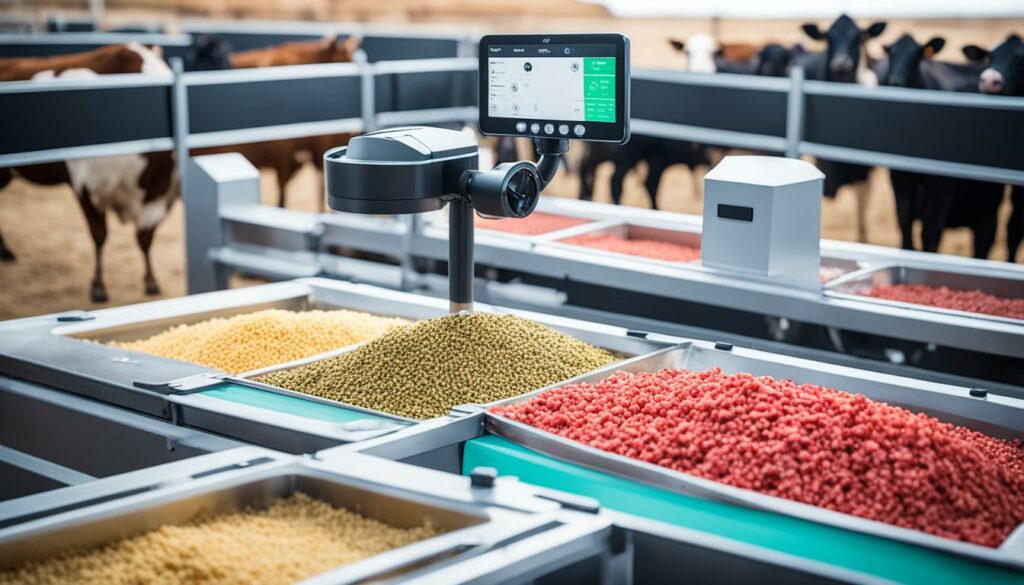
Take computer vision drones, for example. They help watch over vast areas and hard-to-reach places. This means farmers can keep a closer eye on what and how their animals are eating. By using AI to look for unusual eating habits and movements, farmers can make quick changes to their feeding plans.
Farmers can now keep track of how much their animals eat. This helps spot health problems early. By using AI in this way, the right amount of food is given to each animal. This approach leads to healthier, happier animals.
Thanks to AI, the food each animal gets is perfectly balanced for them. This is vital for their growth and well-being. AI systems constantly check feeding plans against past data. This helps make the food even better as time goes on.
| Feature | Benefits |
|---|---|
| Computer Vision Drones | Access large areas, monitor remotely |
| AI Models | Early detection of health issues |
| Real-Time Behaviour Monitoring | Identify stress, discomfort, feeding changes |
| Nutrient Analysis | Optimised diets, improved health |
AI can also help with common feed problems and spot health issues early. By looking at past health data and genes, AI can help keep animals healthier. This leads to better care of animal health.
In the end, AI is transforming how we think about and manage animal nutrition. It’s all about using data to do things better. This approach helps farm smarter, producing more and looking after the animals better.
Livestock autonomous feeding is changing agriculture as we know it. By using top-notch tech, these systems make feeding easier. They cut down on the need for people to be there all the time. It’s exciting to see the farming world turn to automation for better efficiency and happier animals.
It’s key to know what makes autonomous feeding tick. Smart Ag’s Ranch Rover and Lely’s Vector are big players. They use AI to feed animals in a precise and automatic way. This means less work for farmers. Plus, they keep an eye on the animals with smart cameras. This helps spot any early signs of sickness. It even makes sure the feed fits well with the animals’ health needs.
Across the globe, AI is making farming better. Smart Ag’s Ranch Rover boosts farm work, making it more productive. Lely’s Vector is a hit in dairy farming. It’s known for its careful feeding and health checks. These examples show how well these systems work. They make farms run smoother and keep the animals healthy.
| Innovation | Key Features | Impact |
|---|---|---|
| Smart Ag’s Ranch Rover | AI-driven feeding, real-time adjustments | Increased efficiency, improved productivity |
| Lely’s Vector | Precision feeding, health monitoring | Enhanced milk yield, better herd health |
| ZELP Wearable Devices | Methane emission reduction, data collection | Improved environmental sustainability |
The trend of tech in farming is here to stay. Livestock autonomous feeding leads the way towards better farms. It helps make farming more friendly to the earth and more efficient.
Environmental sustainability in farming is now more critical than ever. Thanks to AI, the farming sector is achieving big wins. It’s reducing its environmental impact through smart waste management and cutting greenhouse gas emissions.
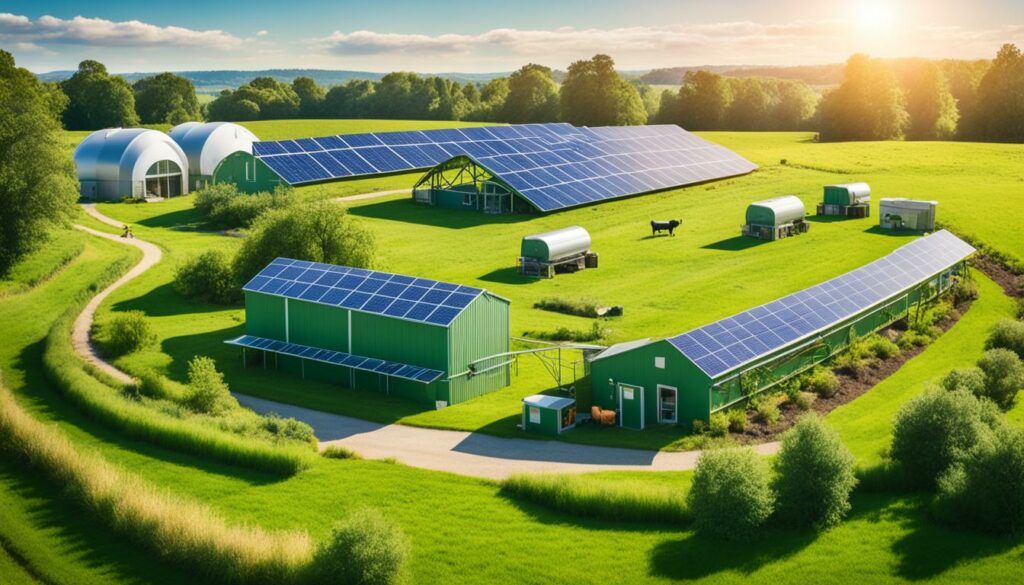
AI is key in lowering greenhouse gas emissions in farming. For instance, ZELP has developed smart devices for cattle. These gadgets track animal breath and help decrease methane, a major greenhouse gas. The use of AI tech in farming marks a positive step towards a greener, more sustainable future for all.
In addition to lowering emissions, AI is changing how farms deal with waste. Smart tech enables accurate sorting and better disposal of waste from farms. This method is not just beneficial for the environment. It also leads to more efficient farming processes and reduced waste.
Farming’s merge with AI brings a hopeful outlook. It’s a future where making money and protecting the planet can go hand in hand through smart technologies.
The farming world is changing thanks to AI technologies. But, in handling livestock, farmers face several hurdles. The most vital challenge is the lack of high-quality data. Without it, using AI solutions isn’t easy.
Getting good data in livestock management is tough. Farming varies a lot, affecting the way data is collected. Digi4Live helps by pushing for shared data and new AI techniques. These can make AI work better.
Farmers may not fully trust AI yet. Their trust is crucial for AI to succeed on farms. Making AI’s benefits clear and fitting the tech to their needs is key. Educating farmers on AI’s benefits for productivity and animal welfare is vital.
Despite the hurdles, AI in farming is set to grow big, from $1.7 billion in 2023 to $4.7 billion in 2028. Tackling data issues and getting farmers to accept AI are big steps. They’re crucial for AI’s bright future in livestock management.
Modern agriculture is being reshaped by AI livestock monitoring. This technology is not just about looking after the animals better. It’s also making farms more efficient. By looking at how AI is used in farming, we learn tips that make farming better.

CattleEye uses overhead cameras and smart software to watch over the cattle. Farmers can now spot unusual behaviour that could mean the animal is unwell. This tech not only keeps the animals healthier but also saves time for the farmers. In another case, using smart equipment powered by AI increased crop production and saved resources.
These stories tell us some important things about using AI in farming. They show us what works best. Here are the key points:
AI in farming includes tools like drones with smart eyes and automatic feeding systems. These help farms run smoothly and look after the environment. The money spent on smart farming is going up fast. By 2025, it’s expected to hit $15.3 billion worldwide, showing how important this tech is becoming.
| Application | Success Metric | Insights |
|---|---|---|
| Tomato Maturity Algorithm | 99.31% Detection Rate | Early maturity detection enhances market readiness. |
| Apple Black Rot Detection | 90.4% Accuracy | Timely disease management reduces crop loss. |
| Insect Detection | 90.18% Accuracy | Precise identification aids efficient pest control. |
AI is transforming how we look after livestock, making farming more efficient and eco-friendly. It lets farmers be super precise and efficient. Technologies using AI help watch over livestock, making checks more accurate and faster.
AI in farming means machines can automatically care for animals, making things easier and reducing work for farmers. Sensors powered by AI check on things like body temperature and activity, spotting signs of sickness early. It also figures out the best food for animals by crunching data from many places, making animals healthier and happier.
AI is also great for keeping an eye on how farming affects the environment. It helps farmers use less energy and water by analysing a lot of data. Real-time health checks for animals with AI catch illnesses early, which makes farms more productive and animals better looked after.
In the future, AI will make farming even better, with more productivity and care for the environment. The market for keeping an eye on animals is growing fast, with companies like Smart Ag and Lely leading the way. Using AI is key to making agriculture work better and last longer.
AI Livestock Monitoring uses high-tech like artificial intelligence. It tracks and looks after livestock health and behaviour. Sensors and smart farming tools make this possible.
Livestock monitoring has shifted from hand checks to digital eyes. This change brought in AI-based animal monitoring and smart sensors. It makes farming more exact and efficient.
Technology makes farming smarter. It brings tools that help in better farm management. This boosts farm output and helps the environment too.
Machines using AI watch over animals. They can spot health problems before they get bad. This early warning helps farmers keep animals healthy.
Health analytics offer instant info on animal health. This helps make smarter choices. It lifts farm management by being more precise with animal care.
It’s all about tailoring animal care using data and tools. This ensures each animal is at its best. Health, welfare, and productivity all see improvements.
They use tags, sensors, and quick data collection. This makes looking after animals easier. It also helps them live better, all while making farming smoother.
AI gives constant checks and smart advice for animal care. This means animals are always well looked after. They live in better conditions because of this.
We aim for better sensors, feeding, and waste solutions in AI farming. These goals target more efficiency and greener farming.
By 2030, the market could hit USD 3.7 billion. Its growth shows more farms embrace tech for managing their operations.
Special sensors keep an eye on animals’ heat and activity. This helps with health care and knowing a farm’s impact on the environment.
They offer live whereabouts with GPS and more. This boosts safety and health checks for animals out in the field.
AI makes diets that fit each animal’s needs. This makes them grow strong and stay healthy.
AI controls tools like Smart Ag’s Ranch Rover and Lely’s Vector for feeding. These show big steps in saving work and farm efficiency.
AI cuts down on farm pollution and waste. For example, ZELP’s tech for cattle helps farms be greener.
Getting enough good data and getting farmers to trust AI are hurdles. More work is needed to show AI’s real benefits.
Yes, many farms are seeing AI’s good results. They produce more, take better care of animals, and manage the farm better because of AI.